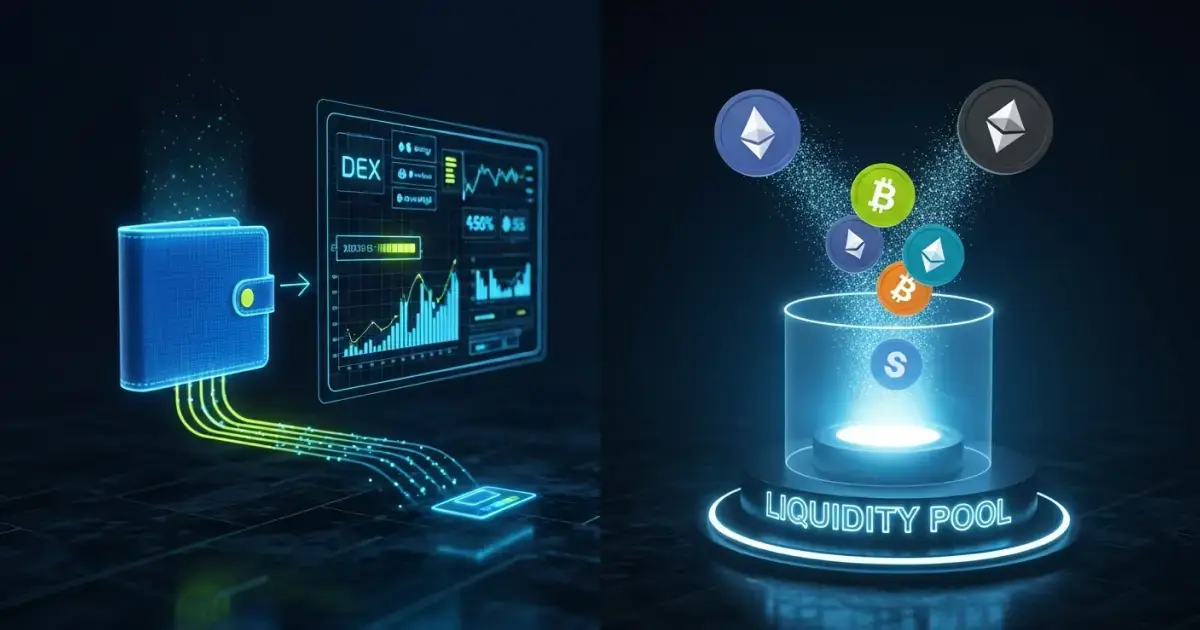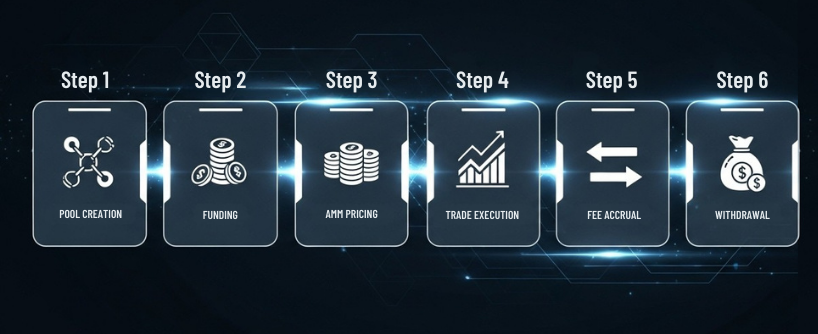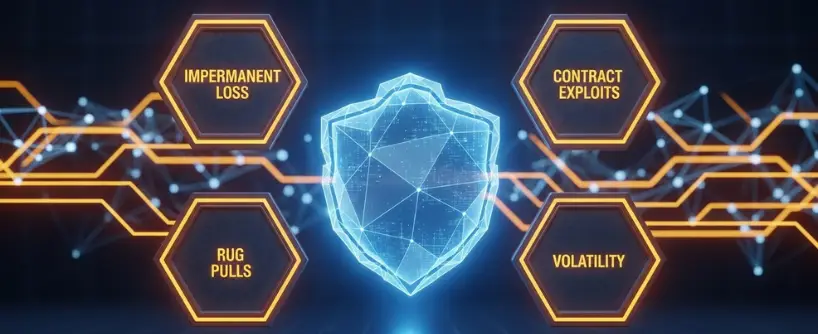
The world of decentralized finance (DeFi) has created new ways for people to earn, trade, and interact with digital assets. One of the most important innovations powering this ecosystem is the liquidity pool. Crypto liquidity pools play a fundamental role in DeFi by facilitating decentralized trading, enabling users to swap tokens seamlessly without traditional order books. Without liquidity pools, decentralized exchanges (DEXs) and automated market makers (AMMs) would not function. Instead of relying on centralized brokers or financial institutions, DeFi platforms use smart contracts and community-provided liquidity as a decentralized solution to traditional market makers, keeping markets running without centralized intermediaries.
For beginners, liquidity pools may sound complicated, but the concept is simple: they are like shared vaults of cryptocurrency. Anyone can contribute to these vaults and, in return, earn a share of the rewards. This model democratizes finance, making it possible for anyone with internet access to become a market participant. By lowering barriers to entry, liquidity pools promote financial inclusion and provide broader access to financial services for users worldwide. In this guide, we will break down what liquidity pools are, how they work, their benefits, risks, and future potential. We will also answer common questions and provide a glossary of important terms.
What Are Liquidity Pools?

A liquidity pool starts with the creation of a trading pair and the deployment of a smart contract that defines the pool’s structure, including how token deposits and initial price setting work. A liquidity pool is a collection of cryptocurrency tokens locked in a smart contract. These pooled funds are used to facilitate trading, lending, or other activities within a DeFi protocol. DeFi protocols utilize liquidity pools to enable decentralized trading, yield generation, and asset transfers without intermediaries. In traditional finance, liquidity is supplied by market makers or financial institutions. In DeFi, liquidity is supplied by everyday users who deposit their tokens into pools.
When users provide liquidity by depositing tokens into a pool, they become liquidity providers (LPs). LPs receive LP tokens that represent their share of the pool. These LP tokens correspond to the underlying assets deposited in the pool and can later be redeemed for the original tokens plus any fees or rewards earned.
Liquidity pools form the backbone of DeFi by:
- Replacing centralized order books.
- Allowing peer-to-peer trades without middlemen.
- Enabling decentralized applications (dApps) to function.
- Creating opportunities for passive income through trading fees and yield farming.
Why Liquidity Matters in DeFi

Liquidity is the lifeblood of any financial system. In simple terms, liquidity means how easily an asset can be bought or sold without impacting its price too much.
- In centralized markets, large institutions act as market makers, ensuring that trades are always matched.
- In DeFi, liquidity pools take over this role, and the selection of token pairs in these pools is often influenced by market demand, as trading activity and user interest determine which assets are paired together.
If liquidity is low, prices can swing dramatically when someone makes a trade. This is known as slippage. Illiquid markets are especially prone to dramatic price swings and higher volatility, making trades riskier. For example, if you try to swap $1,000 of ETH for USDT in a pool with only $10,000 liquidity, the price may move against you significantly. Low liquidity increases the risks of inefficient trades, higher slippage, and potential market manipulation. But if the pool has $10 million in liquidity, the same trade barely affects the price. More liquidity in a pool also improves trading volume and reduces slippage, making the platform more attractive to users.
Liquidity pools make sure that DEXs remain usable and efficient, even without centralized intermediaries.
Types of Liquidity Pools

Liquidity pools are not one-size-fits-all. Different pools are designed for different purposes, and understanding these distinctions helps providers make better choices based on their goals, risk appetite, and market conditions. Below are the main types of liquidity pools in decentralized finance:
1. Volatile Asset Pools
These are the most common pools, pairing two cryptocurrencies with fluctuating prices (for example ETH/USDT or BTC/ETH). They tend to generate high trading volume and, as a result, higher fee rewards. However, they also carry a higher risk of impermanent loss because token prices can change rapidly. Volatile asset pools are better suited for investors who are comfortable with market swings and willing to balance higher risks for potentially larger returns.
2. Stablecoin Pools
Stablecoin pools involve tokens pegged to fiat currencies, like USDC/USDT or DAI/USDC. Since stablecoins maintain relatively stable values, these pools carry lower risk of impermanent loss. While returns may be smaller compared to volatile pools, the predictability of stablecoin pools makes them attractive for risk-averse investors seeking steady and reliable income. They are also crucial for traders who need deep, low-slippage markets to move between stable assets.
3. Weighted Pools
Unlike the traditional 50/50 model, weighted pools allow assets to be deposited at custom ratios, such as 80/20 or 70/30. For example, Balancer pools enable LPs to contribute more of one asset and less of another. This flexibility reduces exposure to impermanent loss and allows for more personalized investment strategies. Weighted pools are ideal for advanced providers who want greater control over portfolio risk and exposure.
4. Multi-Token Pools
Most liquidity pools involve two tokens, but multi-token pools can hold three or more. For example, a pool could include ETH, USDC, and DAI simultaneously. These pools allow for more diversification and often support more complex trading pairs. Platforms like Balancer popularized this model, offering pools with up to eight tokens at once. They tend to attract users who want broad exposure to multiple assets with a single liquidity position.
5. StableSwap Pools
StableSwap pools are a specialized type of stablecoin pool optimized for low slippage trading between assets that stay near the same value, like USDC, USDT, and DAI. Curve Finance pioneered this model, and it has become the backbone of stablecoin trading in DeFi. By using advanced algorithms, StableSwap pools minimize price impact even for large transactions, making them essential for institutions and high-volume traders.
6. Single-Sided Liquidity Pools
Traditional pools require equal deposits of two assets, but some protocols now allow “single-sided liquidity,” where you contribute just one token. The protocol handles the balancing automatically, often using synthetic assets or bonding curves. This lowers the barrier to entry, although rewards may be lower compared to standard pools. Single-sided liquidity is gaining popularity among beginners who may not hold both assets in a pair.
7. Incentivized Pools (Liquidity Mining)
Many protocols launch incentivized pools to attract liquidity by offering additional rewards in governance or native tokens. For example, SushiSwap and PancakeSwap distribute extra tokens to providers who stake in selected pools. While yields can be very high initially, these pools often face declining rewards over time as token emissions increase. They appeal to providers looking for short-term opportunities but require caution due to inflation risks.
8. Cross-Chain Liquidity Pools
Cross-chain pools enable assets to move between different blockchains, improving interoperability and access to liquidity across ecosystems. For example, a cross-chain ETH/USDC pool might operate simultaneously on Ethereum, BNB Chain, and Polygon. These pools are becoming increasingly important as multi-chain DeFi ecosystems expand. They allow users to trade or provide liquidity seamlessly across networks without relying on centralized bridges.
9. NFT Liquidity Pools
Some DeFi protocols now use liquidity pool models for non-fungible tokens (NFTs). Instead of trading NFTs directly in peer-to-peer marketplaces, pools hold collections of NFTs and allow users to swap or fractionalize them. This innovation improves NFT market liquidity and enables DeFi-style trading strategies within the digital collectibles market.
How Do Liquidity Pools Work? Step-by-Step

Let’s walk through how liquidity pools function.
Step 1: Funding the Pool
Users deposit tokens into a smart contract, creating a pool of assets. This process is known as add liquidity, where participants contribute their tokens to the pool to support trading and earn rewards.
Step 2 Automated Market Maker Pricing
Instead of relying on traditional order books, liquidity pools use an Automated Market Maker (AMM) algorithm to set prices. Most AMMs, like Uniswap, use the constant product formula (x * y = k), which ensures that the product of the two token reserves remains constant. This formula allows the pool to automatically adjust prices as trades occur, maintaining balance and liquidity. The AMM algorithm also enables price discovery by determining token prices based on the ratio of assets in the pool, providing real-time and decentralized price setting.
Step 3: Trading
Traders interact directly with the pool, swapping one token for another at the current rate set by the AMM. This system allows for efficient trading by automating price calculations and eliminating the need for centralized order books, resulting in faster and more streamlined transactions.
At a high level, this is how crypto liquidity pools work: users add liquidity, AMMs set prices using the constant product formula, and traders benefit from efficient, automated trading and real-time price discovery.
Pool Creation
A developer creates a smart contract that defines the rules of the pool. The pool usually supports a pair of tokens (for example, ETH/USDC), known as trading pairs, which are essential for enabling token swaps and providing liquidity in decentralized exchanges.
Funding the Pool
Liquidity providers deposit equal values of two tokens. For instance, if ETH is $2,000 and USDC is $1, an LP would deposit 1 ETH and 2,000 USDC to keep the pool balanced.
Automated Market Maker Pricing
Unlike traditional exchanges that use order books, DeFi uses Automated Market Makers (AMMs). The most common pricing model is: x * y = k
Here, x and y are the amounts of each token in the pool, and k is a constant. This formula ensures that the ratio of tokens always determines the price.
Trading
Traders interact with the pool to swap tokens, which is designed to facilitate trades between different assets. Each trade slightly shifts the token ratio, which in turn adjusts the price.
Rewards
Every trade incurs a fee (usually around 0.3%). These fees are collected and distributed to liquidity providers according to their share of the pool. Users earn rewards not only from trading fees but also from other incentives designed to encourage participation. Some pools implement liquidity mining, where participants can earn additional token rewards by staking or locking their assets. In liquidity pools yield farming, users can stake their LP tokens to receive extra rewards, maximizing their returns through these incentivized strategies.
Withdrawing Liquidity
Liquidity providers can exit anytime by withdrawing their tokens. When withdrawing, they redeem their liquidity pool tokens, which serve as proof of their contribution and entitle them to a proportional share of the pool plus accumulated fees. However, the amount of each token may have changed due to price movements.
Benefits of Liquidity Pools

Decentralization
Liquidity pools eliminate the need for centralized order books and intermediaries by enabling decentralized liquidity, where protocol-driven mechanisms allow the community to provide and access liquidity without relying on a central authority. Anyone can provide liquidity or trade directly through smart contracts.
Passive Income
By contributing to pools, users earn trading fees and, in some cases, governance tokens. This creates an opportunity for regular users to generate income. By participating in these liquidity pools, users can earn passive income through ongoing trading fees and rewards.
Accessibility
Unlike traditional finance where only institutions provide liquidity, in DeFi anyone can become a liquidity provider with as little as a few dollars.
Always-On Markets
Liquidity pools ensure that trading is available 24/7, regardless of whether centralized markets are open.
Flexibility
Liquidity pools exist for thousands of token pairs, stablecoins, NFTs, and even synthetic assets. This flexibility fuels the growth of DeFi ecosystems.
Risks of Liquidity Pools

Impermanent Loss
This happens when the price of tokens in the pool changes compared to simply holding them. If ETH doubles in value while paired with USDC, LPs may end up with less ETH when withdrawing than if they had held ETH alone.
Smart Contract Exploits
Bugs or vulnerabilities in pool contracts can be exploited by hackers. Lending pools and smart contracts carry risks, especially when it comes to vulnerabilities that can be targeted during periods of market volatility. Billions of dollars have been lost in DeFi due to poorly audited code.
Market Volatility
Sharp price movements can erode the value of tokens in a pool. This risk is especially high in small-cap tokens.
Rug Pulls
In some cases, malicious developers drain pools, leaving LPs with worthless tokens. This is more common in unaudited, low-volume projects.
Regulatory Risks
Governments may impose regulations on DeFi platforms, which could impact how liquidity pools operate.
Real-World Examples of Liquidity Pools
- Uniswap – Pioneer of AMMs, enabling easy token swaps.
- Curve Finance – Optimized for stablecoins, minimizing slippage.
- Balancer – Allows multi-token pools with custom weightings.
- SushiSwap – Adds yield farming incentives for LPs.
- PancakeSwap – Popular on Binance Smart Chain with low transaction costs.
Each platform has unique features, but all rely on the same principle: pooled liquidity enables decentralized trading.
Use Cases of Liquidity Pools
- Decentralized Trading – Powering DEXs without order books, liquidity pools facilitate transactions by enabling direct, decentralized trading without traditional intermediaries.
- Lending and Borrowing – Liquidity supports lending protocols like Aave and Compound.
- Yield Farming – LPs can stake their tokens to earn extra rewards.
- Synthetic Assets – Pools back tokens that mirror real-world assets.
- Cross-Chain Liquidity – Bridges enable tokens to flow between blockchains. Cross chain swaps allow users to exchange assets across different blockchains, improving interoperability and liquidity efficiency.
Future Trends of Liquidity Pools (2025 and Beyond)
- Layer 2 Integration – Faster and cheaper pools through rollups.
- Cross-Chain Liquidity – Seamless swaps across different blockchains.
- Institutional Adoption – Hedge funds and banks exploring liquidity provision.
- AI-Powered Optimization – Algorithms will rebalance pools for efficiency.
- Compliance-Friendly Pools – Pools with built-in KYC/AML mechanisms may emerge.
Frequently Asked Questions
What is a liquidity pool in crypto?
A liquidity pool is a digital vault of tokens locked into a blockchain smart contract. These pooled assets allow decentralized applications and exchanges to operate without traditional intermediaries like banks or brokers. In practice, liquidity pools ensure that traders can buy or sell assets instantly by pulling from the pool’s reserves. Instead of relying on a centralized order book, buyers and sellers interact directly with the pool. This design keeps DeFi markets active 24/7, making them accessible to anyone with an internet connection.
How do liquidity providers earn money?
Liquidity providers earn a share of the transaction fees generated by the pool. Every time someone makes a swap using that pool, a small fee is charged and distributed proportionally among all providers. For example, if you contribute 10 percent of the pool’s liquidity, you receive 10 percent of all fees collected. Some protocols also issue additional incentives such as governance tokens, creating opportunities for even higher returns. The longer and larger your contribution, the more you can earn.
What is impermanent loss in detail?
Impermanent loss occurs when the price ratio of tokens inside the pool changes compared to when you deposited them. If one token increases or decreases sharply in price while the other stays stable, you may withdraw less value than if you had simply held the tokens in your wallet. This “loss” is called impermanent because it can be reduced or even erased if prices return to the original ratio. However, if you withdraw during the imbalance, the loss becomes permanent. Understanding impermanent loss is essential for risk management. Having a solid understanding of how liquidity pools work and the risks involved is crucial before participating.
How risky are liquidity pools overall?
Liquidity pools offer attractive rewards, but they also carry several risks. The most common is impermanent loss, which can reduce the value of your holdings. Technical risks include vulnerabilities in the smart contracts that power pools. If hackers exploit these weaknesses, funds can be stolen. There is also market risk, since volatile token prices can reduce your overall portfolio value. Finally, some smaller projects pose the danger of “rug pulls,” where developers withdraw liquidity and abandon the project. Choosing reputable platforms with strong audits helps reduce these risks significantly.
Can I provide liquidity with only one token?
In most cases, liquidity pools require pairs of tokens deposited in equal value. However, some protocols now allow “single-sided liquidity,” meaning you can contribute only one token, and the system will balance it using the other side of the pool. When you add liquidity in this way, the protocol handles the conversion and balancing automatically. While this reduces entry barriers, it may also reduce rewards compared to standard pools. For beginners, starting with traditional two-token pools is often the simplest and safest option.
What are LP tokens and why are they important?
When you deposit tokens into a liquidity pool, you receive LP (Liquidity Provider) tokens as proof of your share in the pool. These LP tokens can be redeemed later for your share of the assets plus any accumulated fees. Many DeFi platforms also allow you to stake LP tokens in additional protocols to earn extra rewards, a practice known as yield farming. In short, LP tokens are not just receipts but can also act as valuable assets in the broader DeFi ecosystem.
Do liquidity pools exist outside Ethereum?
Yes. While Ethereum pioneered DeFi, liquidity pools are now found across many blockchains including Binance Smart Chain, Polygon, Avalanche, Solana, and Arbitrum. Each network offers unique benefits such as faster transactions or lower fees. The choice of blockchain impacts your costs and potential rewards, so users often compare networks before committing funds. Cross-chain bridges are also expanding access by allowing liquidity to move across ecosystems.
What happens if a pool has no liquidity?
If a liquidity pool has little or no liquidity, traders cannot execute meaningful transactions without massive slippage. This makes the pool unattractive to users and can even render it useless. A healthy pool requires consistent contributions from providers, and many protocols incentivize participation with rewards. Before trading or depositing, always check the total value locked (TVL) to gauge whether the pool has enough liquidity.
What are stablecoin pools and why are they popular?
Stablecoin pools consist of tokens pegged to assets like the US dollar, such as USDT, USDC, or DAI. Because stablecoins maintain relatively stable values, these pools reduce the risk of impermanent loss and provide predictable returns. They are popular among conservative investors who want steady income from transaction fees without the extreme volatility of regular crypto pairs. Stablecoin pools are also essential for traders who need reliable liquidity to move in and out of volatile assets. These pools are especially attractive for low slippage trades, as specialized AMMs help minimize trading slippage and impermanent loss.
How do I calculate returns from liquidity pools?
Returns from liquidity pools depend on several factors: the trading volume in the pool, the fee percentage, your share of the pool, and any additional rewards offered by the platform. To estimate potential earnings, you can use online APY calculators that project annualized yields based on recent trading activity. However, these tools do not account for impermanent loss, so actual results may differ. Regular monitoring of pool performance is crucial for accurate assessment.
Can I lose all my money in a pool?
Yes, it is possible under extreme circumstances. If the tokens in the pool collapse in value or the smart contract is exploited, liquidity providers can lose their entire deposit. This is why risk management is essential. Diversifying across multiple pools, using well-audited protocols, and avoiding risky small-cap tokens can significantly reduce the likelihood of a total loss. Treat liquidity provision as an investment that requires careful research, not as a guaranteed profit stream.
Are liquidity pools legal?
Liquidity pools themselves are legal, but regulatory environments vary across countries. Some governments treat DeFi platforms as financial institutions, requiring compliance with know-your-customer (KYC) or anti-money laundering (AML) laws. Others have not yet issued clear guidelines. It is the responsibility of users to check their local regulations and ensure they are not violating any laws. As DeFi matures, compliance requirements may become more standardized worldwide.
Glossary
- Liquidity Pool: A smart contract that holds crypto assets for trading and lending.
- Liquidity Provider (LP): An individual or entity that deposits assets into a pool.
- LP Tokens: Proof of ownership representing a provider’s share of a pool.
- Automated Market Maker (AMM): An algorithm that sets token prices in pools.
- Impermanent Loss: Loss of value when token prices diverge after pooling.
- Yield Farming: Strategy of staking or moving assets across pools to maximize returns.
- Staking: Locking tokens in a protocol to secure it and earn rewards.
- DEX (Decentralized Exchange): A platform that enables trading without intermediaries.
- Slippage: Price change that occurs during a trade due to liquidity levels.
- Stablecoin: Cryptocurrency pegged to a stable asset like USD.
- Gas Fees: Fees paid for executing transactions on blockchains.
- Rug Pull: Fraud where developers drain liquidity and abandon a project.
- Cross-Chain Bridge: Protocol allowing tokens to move across blockchains.
- Oracles: Services that provide real-world data to smart contracts.
- APY (Annual Percentage Yield): Standardized metric for measuring yearly returns.
- Governance Token: Token granting holders voting rights in a protocol.
- Smart Contract: Self-executing code that automates transactions.
- Circulating Supply: The number of tokens currently in use.
- Total Value Locked (TVL): Total value of assets in a DeFi protocol.
- Slippage Tolerance: Maximum deviation from expected price that a user accepts.
Conclusion
Liquidity pools are the foundation of decentralized finance. They make it possible for traders to swap tokens instantly, for investors to earn fees, and for developers to build innovative applications without relying on centralized systems.
By contributing to liquidity pools, users not only support the DeFi ecosystem but also open the door to passive income. However, risks such as impermanent loss and smart contract vulnerabilities must always be considered.
For beginners, liquidity pools provide an excellent entry point into DeFi. Start with established pools, diversify your holdings, and learn continuously. With the right approach, liquidity pools can be both rewarding and educational.
About Bitunix
Bitunix is one of the world’s fastest growing professional derivatives exchanges, trusted by over 3 million users across more than one hundred countries. Ranked among the top exchanges on major data aggregators, Bitunix processes billions in daily volume and offers a comprehensive suite of products including perpetual futures with high leverage, spot markets, and copy trading. Users can trade bitcoin and other major cryptocurrencies on the platform, taking advantage of advanced trading features. Known for its Ultra K line trading experience and responsive support, Bitunix provides a secure, transparent, and rewarding environment for both professional and everyday traders. Bitunix Academy adds structured lessons so you can build skills while you trade.
Bitunix Global Accounts
X | Telegram Announcements | Telegram Global | CoinMarketCap | Instagram | Facebook | LinkedIn | Reddit | Medium
Disclaimer: Trading digital assets involves risk and may result in the loss of capital. Always do your own research. Terms, conditions, and regional restrictions may apply.









